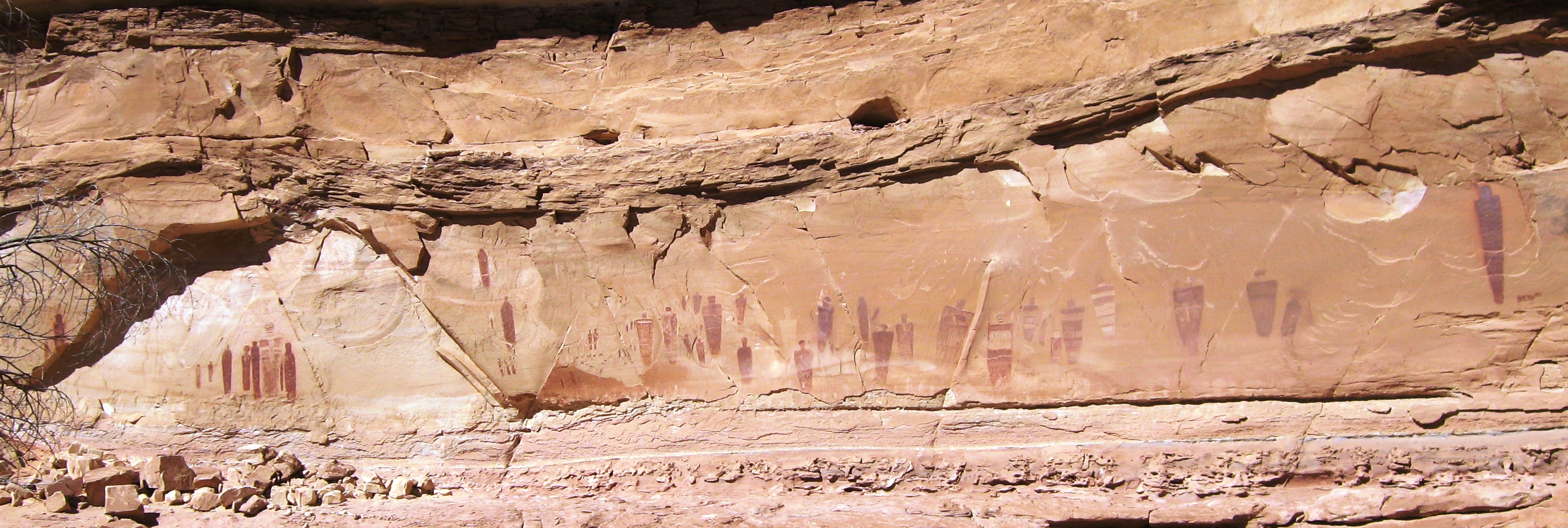(continued from Green River, Part 2)
Sunday
Sunday morning we got up, enjoyed an even bigger free breakfast at the Tamarisk Restaurant, checked out, and headed east to a place called Sego Canyon. This is another place in the area that I’d never been. There’s a ghost town up in a canyon somewhere, but my real interest was the rock art.
The drive to the rock art was easy, even through snow and mud in my Honda Civic. There’s rock art of three different types here, not counting the modern American vandalism. One panel has Ute rock art, one panel has Fremont culture rock art, and one panel has Barrier Canyon style rock art. Those are the three main traditions or styles of rock art found in southwest Colorado and southeast Utah.
pictograph: an ancient or prehistoric drawing or painting on a rock wall
petroglyph: a carving or inscription on a rock




My personal favorite is Barrier Canyon rock art, because it has all these weird figures that look vaguely like scary, dark, faceless humans with aspects of what looks a lot like alien creatures – bug eyes, antennas, etc.
Years ago, I hiked into Horseshoe Canyon, the least-known district of Canyonlands National Park. It used to be called Barrier Canyon, and the rock art at Great Gallery there is the “type site” of Barrier Canyon style rock art found in a hundred mile radius of there.

Tangent
A “type specimen” is a common term for a specific sample or drawing scientists consider to have the definitive characteristics of a species. For example, according to Wikipedia, “the type specimen for the species Homo neanderthalensis was the specimen ‘Neanderthal-1’ discovered by Johann Karl Fuhlrott in 1856 at Feldhofer in the Neander Valley in Germany.”
In geology, a lot of geological formations are named after a specific place where that formation was first seen or is most definitively seen. For example, in the desert southwest, there’s a type of rock called “Wingate sandstone” because it’s very prominent at Wingate, Arizona. Similarly, the “Chinle Formation” is prominent at Chinle, Arizona and the “Kayenta Formation” is prominent at Kayenta, Arizona. In geology these are called the “type locality”.
In archaeology, the same idea is called a “type site”. For example, there was a prehistoric culture in what’s now the western US called the “Clovis culture”. Maybe you’ve heard of “Clovis point” arrow heads. Well, this is named after Clovis, New Mexico just as the “Folsom Tradition” was first identified near modern day Folsom, New Mexico. Apparently, “type site” is also used to indicate the place where a particular style of rock art is most definitive.
According to the BCS Project website, “The Great Gallery is the type-site for the Barrier Canyon style and the largest of the Barrier Canyon style rock art gallery sites.” But the people who made it aren’t called Barrier Canyon people, they’re called Western Archaic people, which I think essentially means “they were here so long ago (6000 years ago) that nobody really knows which modern day Native Americans descended from them, if any”.
End of tangent
There is also some rock art across the road on private land. This one’s a mix of styles, with English signatures and other modern graffiti.

After walking around in the muddy snow to see all the art, we headed for Colorado. We stopped for gas in Fruita, and then drove over the Colorado National Monument, something I hadn’t done in decades.

Then we made a stop at the Grand Junction Memorial Gardens so I could say hi to my grandparents, all four of whom are there. And then we drove on to Glenwood Springs. After a small meal of Mexican food at Jilbertitos, we spent a couple hours soaking at Iron Mountain Hot Springs, and then called it a night.
Monday
Monday morning was just driving, for the most part. Fortunately, traffic was way better than it had been on the way west on Friday, and we got to Denver in time for a lunch of pho. And that marked the end of our long weekend away.
It was a nice getaway. I got to see the Ken Sleight exhibit and the rest of the museum, some rock art, some beautiful geology, and a missile test site. All with good food and good company.
Thanks for reading. If you enjoyed my story and photos, put your email address in the box to get notified of future posts.

I enjoyed your short travel blog. The red rocks are so beautiful and the petroglyphs eerily fascinating.